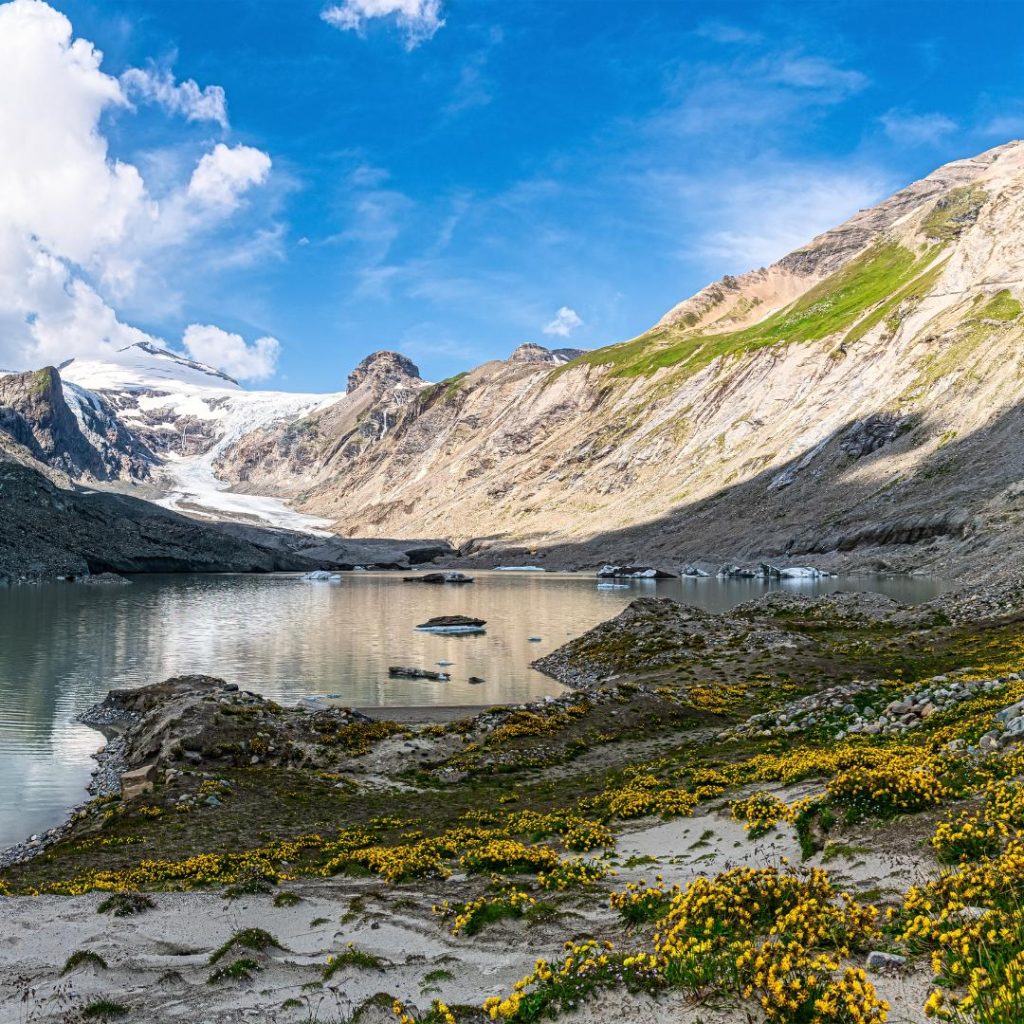From glacier extinction: The Alpine Association measures the greatest loss of length on the Pasterze since measurements began

The volunteer glacier surveyors of the Austrian Alpine Association observed or measured 93 glaciers in Austria for their current glacier report: All but one retreated in the 2022/23 glacier budget year. Compared to last year's report, the former ice giants have become 23.9 m shorter on average from 2022 to 2023. This is not only the third-highest value in the 133-year history of the Alpine Association Glacier Monitoring Service, but also in the last seven years.
A "landmark of Austria" continues to melt rapidly. Never before have the volunteer glacier measurers of the Austrian Alpine Association measured a greater retreat in the length of the Pasterze: Compared to last year's glacier report, Austria's largest glacier retreated in length by a total of 203.5 m, a negative record value for the Pasterze. In total, the Pasterze lost 14.03 million m³ of ice at the glacier tongue, which corresponds to a cube with an edge length of 241 m (almost the height of the Danube Tower in Vienna).
Three record figures within the last 7 years
The average retreat of the 79 glaciers measured in both 2022 and 2023 was -23.9 m. The trend for 14 other glaciers was determined by photo comparisons or multi-year values. In the 133-year history of the Alpine Association Glacier Measurement Service, this is the third-highest value after those of the measurement years 2021/22 with -28.7 m and 2016/17 with -25.2 m - all three negative record values were therefore achieved within the last 7 years.
"A late but very long and warm melting period in 2023 was once again the main cause of the extremely unfavorable glacier conditions," analyzes Andreas Kellerer-Pirklbauer from the Austrian Alpine Association . He continues: "A new absolute temperature maximum of 15.7°C was measured on the glaciated Sonnblick on July 11, 2023."
Largest retreat in Carinthia and Tyrol
The maximum retreat amounts in the reporting year 2022/23 were significantly higher than those of the previous year, in which no glacier retreated by more than 100 m. In the current reporting year, the five glaciers with the highest retreat amounts were the Pasterze (Carinthia, Glockner Group) with the new record value for this glacier of 203.5 m, the Rettenbachferner (Tyrol, Ötztal Alps) with 127.0 m, the Sexergertenferner (Tyrol, Ötztal Alps) with 93.7 m, the Schlatenkees (East Tyrol, Venediger Group) with 92.8 m and the Fernauferner (Tyrol, Stubai Alps) with 68.0 m.
Glacier report as a "warning signal to climate policy"
According to the Alpine Association's glacier report, there is no longer a glacier in Austria that has a nourishing area that can even come close to maintaining the existing ice mass.
"The Austrian glaciers only exist because of the ice reserves accumulated in the past," Lieb and Kellerer-Pirklbauer explain.
According to the heads of the Alpine Association's glacier measurement service, the current report can therefore be read "as a warning signal to climate policy".
Glacier protection more urgent than ever without exception
For years, the Austrian Alpine Association has been pointing out the urgent need to protect glaciers without exception. According to the Alpine Association, the destructive development of previously untouched glacier areas is anything but appropriate in times of climate crisis.
"A rethink in politics is urgently needed here! We must now move towards nature-compatible tourism - the development of previously untouched glacier areas is an overexploitation of nature," emphasizes Nicole Slupetzky, Vice President of the Austrian Alpine Association, who has been closely connected to the topic of glaciers since childhood through her father, the geographer and glaciologist Prof. Heinz Slupetzky.
According to the Alpine Association, the demand for complete glacier protection, which includes not only the glacier areas but also the glacier forefields - the areas that have been ice-free for 170 years - and moraines, is more urgent than ever.
"Opening up new glaciers and glacier forefields clearly means crossing a red line for us," emphasizes Slupetzky.
For example, there are currently expansion plans for the "Pitztal Glacier" ski area, where three glaciers that have not yet been developed for skiing could be developed. The expansion plans for the "Kaunertal Glacier" ski area would even open up one of the largest remaining glacier areas in the Eastern Alps, the Gepatschferner. It was only in March that the Tyrolean provincial government determined that an environmental impact assessment must be carried out for these plans. In the decision, the responsible authority refers to the serious environmental impacts that are to be expected and assumes, for example, unacceptable effects on the protected landscape and recreational value.
Statistics: Glacier retreat in figures (measurement period 2022/2023)
10 largest declines - length losses in meters:
1st Pasterze (Carinthia, Glockner Group) -203.5
2. Rettenbachferner (Tyrol, Ötztal Alps) -127.0
3. Sexergertenferner (Tyrol, Ötztal Alps) -93.7
4. Schlatenkees (Tyrol, Venediger Group) -92.8
5. Fernauferner (Tyrol, Stubai Alps) -68.0
6. Gepatschferner (Tyrol, Ötztal Alps) -67.0
7. Freiwandkees (Tyrol, Glockner Group) -65.8
8th Marzellferner (Tyrol, Ötztal Alps) -49.9
9th Frosnitzkees (Tyrol, Venediger Group) -46.0
10. Alpeinerferner (Tyrol, Stubai Alps) -43.4






